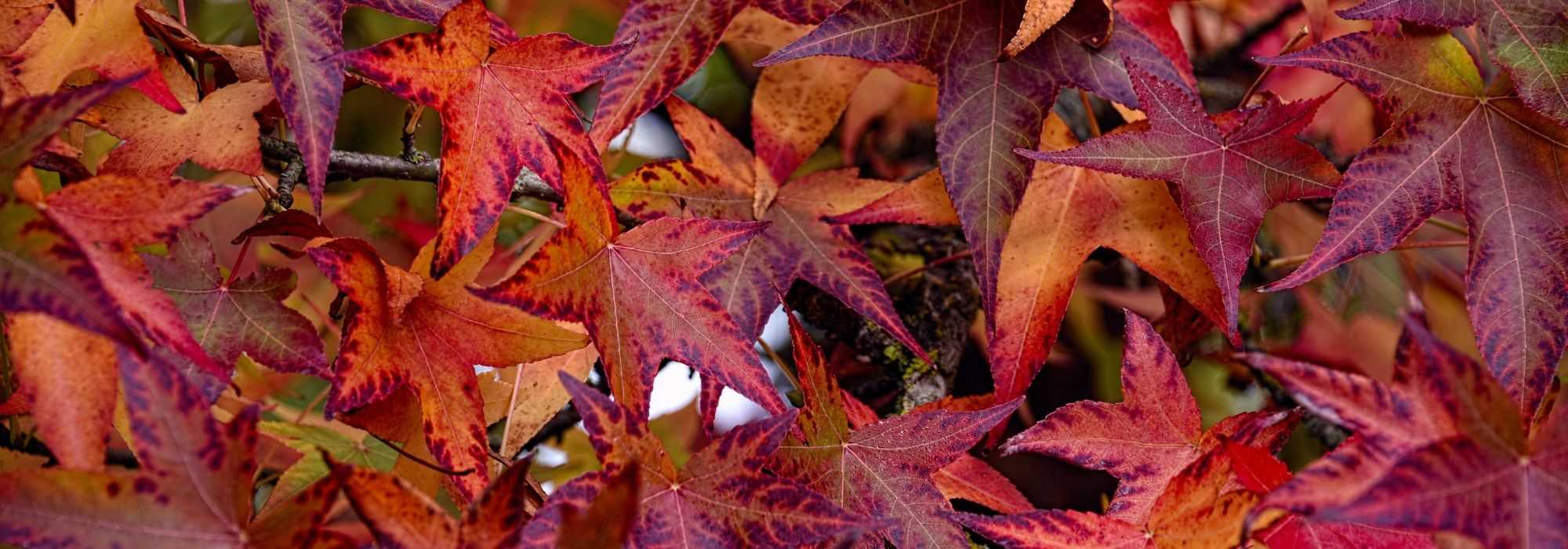
Liquidambar, American Sweetgum: planting, pruning, maintenance
Contents
Liquidambar in a nutshell
- Liquidambar is one of the most beautiful ornamental trees
- Unique in autumn for the beauty of its colourful, glowing foliage
- Easy to grow, it only requires fresh, non-calcareous soil and a prime position
- Resistant to cold and disease, it requires very little attention
- Majestic, it is ideal as a specimen in parks or large gardens, while dwarf Liquidambar will delight bush enthusiasts in smaller spaces!
A word from our expert
Le Liquidambar est sans aucun doute l’un des plus beaux arbres d’ornement pour le jardin. On le retrouve souvent dans les espaces publics comme arbre d’alignement, mais cette majestueuse essence mérite aussi une place de choix au jardin où sa silhouette gracieuse pourra donner toute sa splendeur.
Son principal atout se situe dans son feuillage caduc qui garantit le spectacle à l’automne en virant à l’or, au cuivré et au rouge violacé, autant de nuances chaudes et épicées qui enflamment le jardin quand les jours raccourcissent. L’hiver dévoile son bois précieux, une belle écorce joliment ridée qui ne manque pas de charme, le printemps et l’été son feuillage couleur verte, parfois éclaboussé de jaune.
Si les plus grands sujets comme le Liquidambar styraciflua surnommé plus couramment “Copalme d’Amérique” sont capables d’atteindre 20 m de hauteur, on rencontre également des espèces comme le Liquidambar orientalis ou de nombreux cultivars de dimensions plus modestes qui ne dépassent guère 10 m. Si vous aimez le liquidambar mais que vous le trouvez trop grand et que l’espace est compté dans votre jardin, sachez qu’il existe un liquidambar nain, le Liquidambar styraciflua ‘Gum Ball’, une variété ne dépassant pas 3 m en tous sens qui conviendra bien mieux aux jardins de dimensions réduites.
Rustique, de culture facile, le Liquidambar se plaît au soleil et ne demande pas beaucoup d’attention une fois bien installé.
Avec son port pyramidal, il forme un point de mire remarquable en isolé sur une pelouse, dans un endroit bien dégagé, ou en alignement le long d’une grande allée.
Découvrez sans tarder le liquidambar, cet arbre au feuillage automnal éblouissant qui convient aux grands comme aux petits jardins.
Description and botany
Botanical data
- Latin name Liquidambar
- Family Hamamelidaceae
- Common name Liquidambar, American sweetgum
- Flowering April-May
- Height 3 to 10 m and above
- Sun exposure Sun
- Soil type Clayey and moist
- Hardiness -20°C
Liquidambar is a deciduous tree of the family Hamamelidaceae, like Hamamelis and Parrotia. The genus comprises four tree species native to temperate forests and riverbanks of America, Turkey and Asia.
Liquidambar styraciflua, also called “American sweetgum”, is the best known species. It is available in numerous cultivars selected for their habit, more modest dimensions, leaf shape and colour, such as ‘Gum ball’, a dwarf variety not exceeding 3 m, ‘Golden Sun’ with pale yellow foliage in spring turning green in summer, or ‘Aurea’ with green foliage mottled with yellow.
Liquidambar orientalis, “Oriental liquidambar” or “Styrax of the Levant”, native to Turkey, Liquidambar acalycina or “Chinese liquidambar”, both smaller than their American cousin, and Liquidambar formosana from Taiwan, with foliage equally magnificent in autumn, complete the genus.
In its natural habitat the American sweetgum can reach up to 40 m in height, but in our regions it will rarely exceed 20 m on average with a spread of 3 to 5 m. It grows slowly in first years then rather quickly afterwards, and fairly quickly forms an imposing specimen. New cultivars offer more modest dimensions, seldom exceeding 10 m in height with 3–4 m width after 10 years. It has a very long lifespan of around 150 years.
Slender or columnar, conical or pyramidal, more rarely spherical (‘Gum Ball’) or rounded, habit of Liquidambar varies greatly with species and cultivars. Most often it adopts a pyramidal silhouette, sometimes quite irregular, which rounds with age.
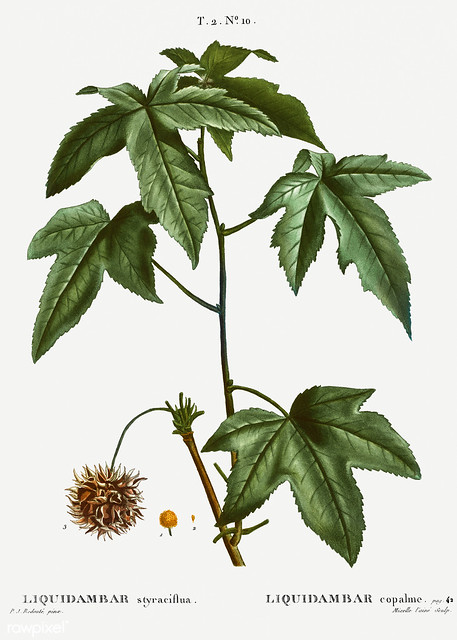
Liquidambar styraciflua – botanical illustration by P.J. Redouté
On a strong taproot this handsome tree develops a very upright trunk with corky bark, dark grey becoming brown-red and fissuring with age. Young shoots show ridges that become corky outgrowths with time. Its wood is prized and so similar to walnut that liquidambar was commonly nicknamed “satin walnut”. Its bark emits a cinnamon scent and exudes a resin, styrax or copal, sometimes called “white balm of Peru”, which gave the tree its name liquidambar meaning “liquid” and “amber”, in reference to the balsamic, aromatic sap of amber colour that flows when the bark is cut.
Liquidambar is particularly valued for its elegant deciduous foliage which dons sumptuous hues, filling garden with warm, spicy tones as days shorten in autumn. Foliage consists of large palmate leaves, divided into 3 to 7 triangular or rounded lobes (Liquidambar styraciflua ‘Rotundiloba’), more or less notched and reminiscent of maple leaves, except that sweetgum leaves are arranged alternately on the shoots rather than opposite. 10 to 18 cm wide with a finely dentate margin, they are pubescent, bristly with reddish hairs on the underside of the lamina.
This ample palmate foliage releases a turpentine scent when crushed.
As with many trees of the Hamamelidaceae family, liquidambar wears magnificently coloured foliage in autumn. From pale green to glossy dark green, sometimes vivid green splashed and flecked with yellow or grey marginate with cream from spring to summer, the leaves take on flamboyant shades — gold, orange, ochre-yellow, coppery, crimson to garnet and purplish-pink in autumn — intensity varying with cultivar and growing conditions.
Flowering of the sweetgum is inconspicuous. In spring, in April, small green-yellow apetalous unisexual flowers appear. Sweetgum is a monoecious species: male and female flowers occur on the same plant. They take the form of aments erect in spikes 5 to 7.5 cm long or spiny, pendulous glomerules 1 to 3 cm in diameter depending on whether they are male or female.
Only after about 25 years of cultivation do female flowers, bristly with green points, develop into fruits — brown, spherical capsules 2.5 to 3.4 cm — which release small winged seeds reminiscent of maple samaras. They persist long into winter attached to shoots by a long peduncle.

Liquidambar styraciflua: foliage green then flamboyant in autumn and its fruit
Very hardy, Liquidambar tolerates winter down to −15 to −20 °C, sometimes further. It thrives in sun and shows best colours on non-calcareous (slightly acidic), deep, heavy (clayey), rich and moist soil. It is an accommodating tree that will tolerate temporarily waterlogged soils, even sea spray and pollution.
Plant as a solitary specimen on a large short grass meadow in a park or sizeable garden, near a pond, in alignment along a wide avenue or on a property boundary in a seaside garden.
The resin, styrax or copal exuded by Liquidambar can be burned as incense and is highly valued for dermatological and anti-stress properties and its ability to combat respiratory ailments. Egyptians used it to embalm mummies, while Native Americans chewed it as a kind of chewing gum. In the 19th century, when Liquidambar was introduced to Europe, copal resin was used in preparation of beauty milks or balms. This aromatic gum also serves as a perfume fixative and is much used by perfumers.
Finally, fragrant and precious wood of liquidambar was much prized in cabinetmaking.
Main species and varieties
Many cultivars of Liquidambar styraciflua, species most commonly grown in gardens are now available, selected for their habit, the colour of their foliage and their more compact growth compared with the typical species. For example, the tree’s impressive size has happily been reimagined in the more compact form of the ‘Gum Ball’ cultivar, which finally allows liquidambar into smaller gardens.
Most popular
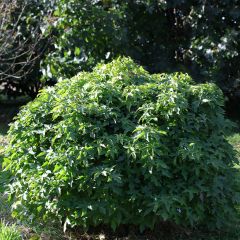
Liquidambar styraciflua Gum Ball - American Sweetgum
- Flowering time May
- Height at maturity 3 m
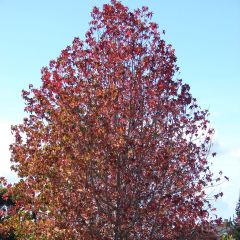
Liquidambar styraciflua - American Sweetgum
- Flowering time May
- Height at maturity 20 m
Our favourites
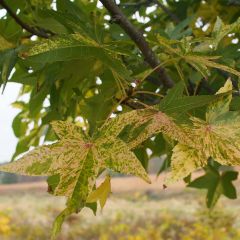
Liquidambar styraciflua Aurea - American Sweetgum
- Flowering time May
- Height at maturity 9 m
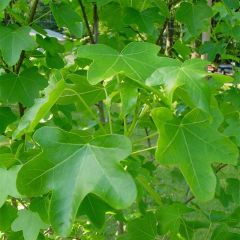
Liquidambar styraciflua Rotundiloba - American Sweetgum
- Flowering time May
- Height at maturity 18 m
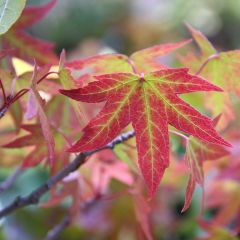
Liquidambar styraciflua Worplesdon - American Sweetgum
- Flowering time May
- Height at maturity 12 m
Discover other Liquidambar - Sweetgum
View all →Available in 1 sizes
Available in 2 sizes
Available in 1 sizes
Available in 2 sizes
Available in 1 sizes
Available in 2 sizes
Available in 1 sizes
Available in 1 sizes
Available in 1 sizes
Available in 1 sizes
Planting Liquidambar
Where to plant?
Liquidambar has a good hardiness down to -15°–20°C, allowing planting in all regions. However, in regions with long winters, give it a well‑sheltered spot as late frosts could damage its aments. Native to wet areas and tolerant of sea spray, it will appreciate rainy coastal climates.
It needs as much light as possible to develop beautiful colours in autumn.
It establishes easily in sun, which will enhance its splendid autumn colours. It likes heavy, cool soils. It requires clay or clay‑loam soil, rich, deep, free‑draining in winter, cool, even moist, as it needs some moisture in the soil to thrive. Its root can tolerate temporary immersion while disliking permanently waterlogged or marshy ground!
It prefers rather acidic soil, in any case not calcareous. While sensitive to calcareous soils, this tree shows resistance to urban pollution and will be a good choice for city gardens.
As its taproot poorly tolerates transplantation, think carefully about location before planting because once well established it will grow about 40–50 cm per year. Give it plenty of room as at ripeness the largest sweetgums will reach 20–22 m in height on average with 7 m spread.
To best enjoy its remarkable autumn display and elegant silhouette, reserve a well‑exposed spot in garden for this tree.
Its size makes it a magnificent specimen planted alone on a large short grass meadow in a vast park or large garden, as an avenue tree to majestically line a path or adorn a body of water in which it can be reflected.
In a garden where space is limited, to thicken a clump of bushes or form a free‑form hedge, prefer a dwarf American sweetgum variety, such as Liquidambar styraciflua ‘Gum Ball’ which will not exceed 3 m in any direction.
When to plant?
Plant Liquidambar or sweetgum preferably in autumn, from September to November to encourage rooting before winter. Container‑grown specimens can also be planted in spring from February to April, avoiding periods of frost or extreme heat.
How to plant?
In very calcareous soil, we recommend adding heather soil at planting. Once established, do not move Liquidambar as its root will very poorly tolerate transplantation. Allow sufficient space — at least 5 to 8 m distance from another tree, 3 to 5 m for cultivars with reduced vigour. You can also plant in groups of 3 or 5 to form a truly majestic grove.
To plant your sweetgum :
- Dig a wide hole at least three times rootball volume
- Spread gravel at bottom of hole to improve drainage
- Mix half potting compost with garden soil; add heather soil if ground is calcareous
- Add well‑rotted compost
- Plant tree at collar level
- Stake if necessary
- Firm soil and water regularly until established and during first years
- Mulch to retain coolness at base during hot periods
For successful planting, watch our video on how to plant a tree properly.
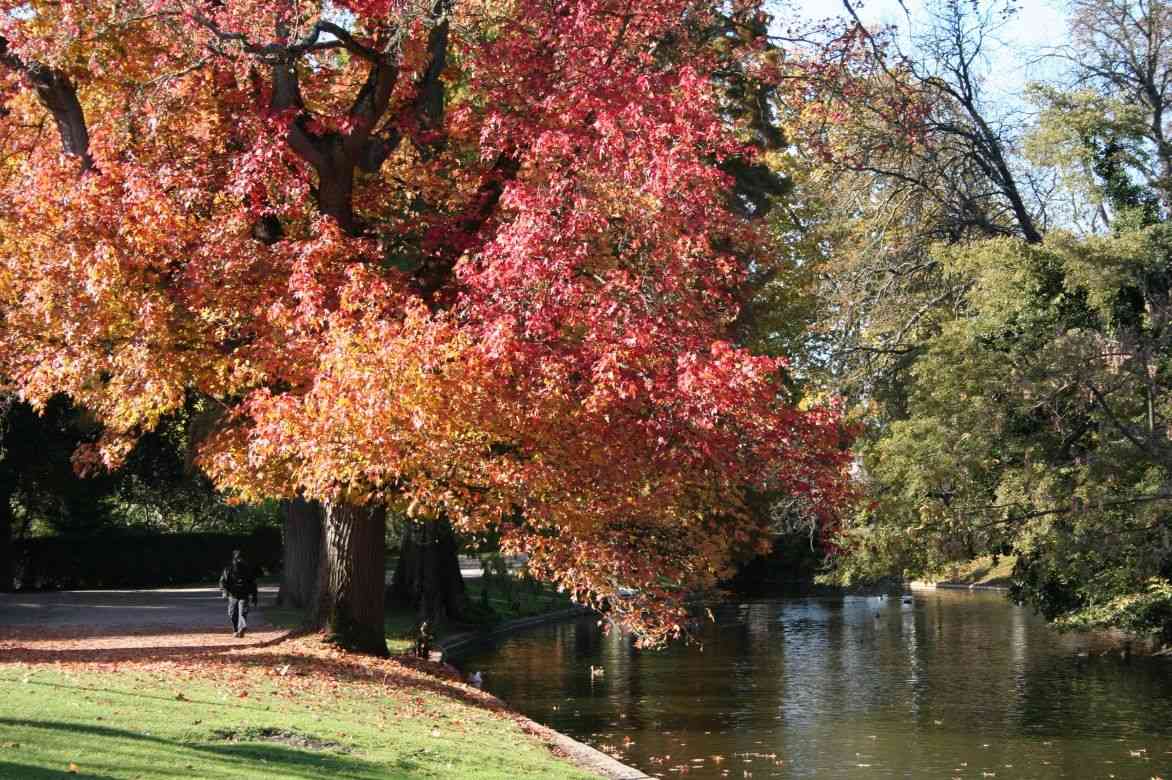
Liquidambar care and pruning
Le Liquidambar requires very little maintenance and grows without any special care.
In its early years, it requires regular watering. In summer, monitor its water requirements and water generously in dry weather. Once well established, it will be content with water from the sky!
A good mulch in summer will help keep soil cool and, in winter, protect young trees from severe frosts.
Each spring, amend soil with good organic fertiliser such as manure or compost.
Pruning is neither necessary nor recommended. In autumn or late winter, you may intervene only to remove dead, dry or damaged wood. Between mid-August and the end of September, lightly prune misplaced or overcrowding branches.
When planted in suitable conditions, Liquidambar proves resistant to diseases.
Multiplication
The Liquidambar (sweetgum) can be propagated by sowing (very long process, may take up to 2 years before germination), by division of suckers, by propagation by cuttings (quite hit-or-miss) and by layering.
By dividing suckers
This is probably simplest propagation method. Some Liquidambars tend to produce suckers around parent plant. In autumn, separate suckers with a spade, cutting root as close as possible to main trunk. Prick out these young plants immediately into fresh soil.
By layering
Layering Liquidambar is simple and produces a new plant identical to parent, however root development is very slow.
- In autumn, bend one of low branches down towards base of tree
- Remove leaves on that part of stem and make incision in bark for a few centimetres
- Dig a furrow close to parent plant
- Lay branch into furrow and bury part so it can root
- Backfill furrow and secure layer with metal hooks
- Raise tip and stake aerial part
- Can separate layer from parent plant and plant out in ground when it has sufficient roots
Taking Liquidambar cuttings
- In autumn–winter, using pruning shear, take hardwood cuttings about 20 cm long
- Remove leaves from lower part of stem
- Plant cuttings in bucket, in a mix of sand, turf and moist soil
- Keep substrate moist until rooting
- Establishment is slow and may take several years
- Once well rooted, repot individually into pots filled with compost and plant out following autumn
Companion plants for American sweetgum
The American sweetgum requires plenty of space, it is an essential oil that stands on its own and will be striking as a majestic pit in the middle of a short grass meadow in a large garden. It remains easy to combine, however, with other plants that enjoy the same cool conditions and deep soil. Resistant to both pollution and sea spray, its presence is imposing in a large city garden as in those by the seaside where it can line an avenue. With its coloured foliage, it is indispensable for creating magnificent autumnal atmospheres.
To compose a symphony of spicy hues, place it near other trees and bushes with colourful foliage such as Ginkgo Biloba, Acer or Japanese maples, Cornus, birches and Hamamelis.
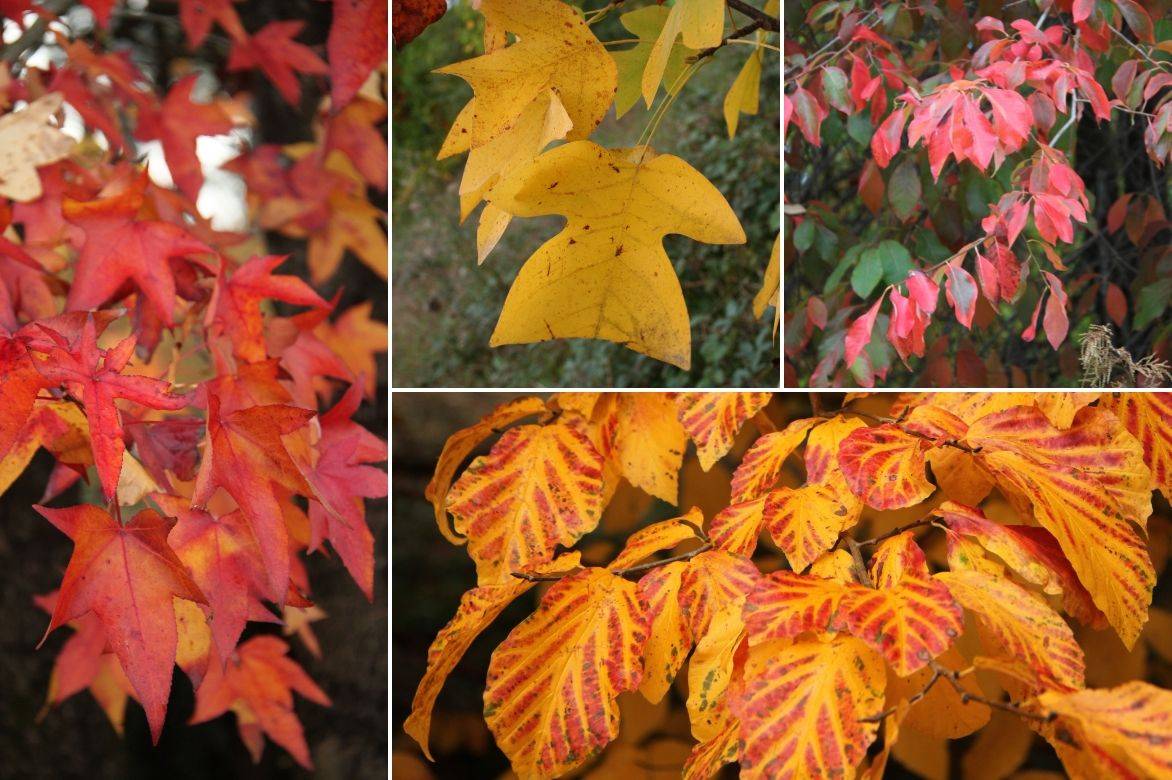
An example of an autumnal association in a copse: Liquidambar styraciflua, Liriodendron tulipifera, Nyssa sylvatica and Parrotia persica
You will create a dazzling autumnal stand by combining it with a Tulip tree (Liriodendron tulipifera), Oxydendron arboreum, Parrotia persica and black gum, which also display sumptuous autumn hues.
This tree, which favours acidic soil, can serve as backdrop to a mix of bushes for heather soil, such as dwarf rhododendrons, hydrangeas and Chinese azaleas.
To fully enjoy its splendour, plant it against an evergreen backdrop of conifers such as Pinus peuce or Macedonian pine, Taxodium distichum or bald cypress or Metasequoia glyptostroboides ‘Gold Rush’.
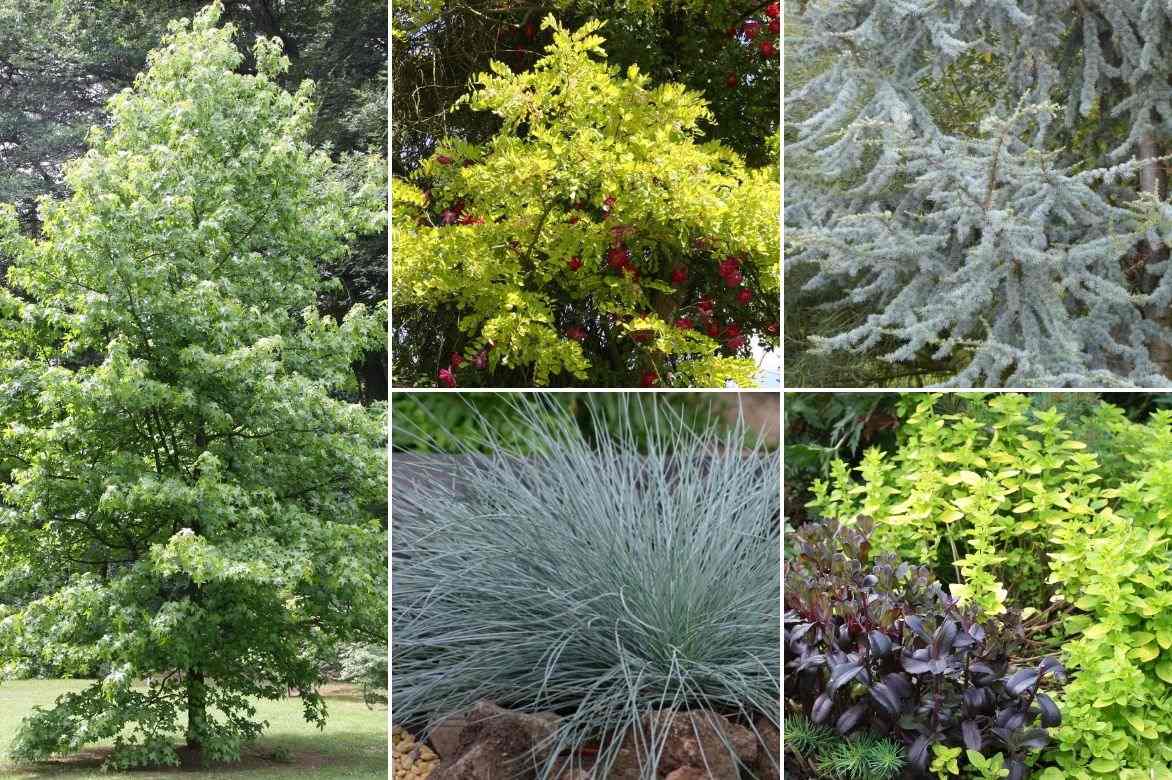
An idea for a planting scheme: Liquidambar styraciflua (or the superb ‘Worplesdon’), Robinia pseudoacacia ‘Frisia’ on which you can train a rambling rose such as ‘American Pillar’ or ‘Maria Lisa’, Cedrus libani ‘Atlantica ‘Glauca’, Festuca ‘Intense Blue’, Sedum ‘José Aubergine’ and Origanum vulgare ‘Aureum’
In spring and summer, accompany its bright green foliage with spring bulbs in acid-green/white tones such as daffodils, Dutch iris, Anemone nemorosa, botanical tulips and train a Clematis montana to climb it to complete this springtime enchantment.
Cover its base with some evergreen ground-cover perennials such as creeping bugle or heucheras with sumptuous evergreen brick-red or purplish-red leaves, dead-nettle, a variegated ivy, hardy geraniums or a fragrant violet that will keep its roots cool.
Smaller liquidambars will easily coexist with a purple hazel, a dwarf Japanese maple, Ginkgo Biloba ‘Blagon’, Toona sinensis ‘Flamingo’ or Chinese mahogany.
Useful resources
- If you want to create a grove of trees and bushes featuring spectacular autumn foliage, discover our collection of bushes with autumn-coloured foliage
- Subscribe!
- Contents
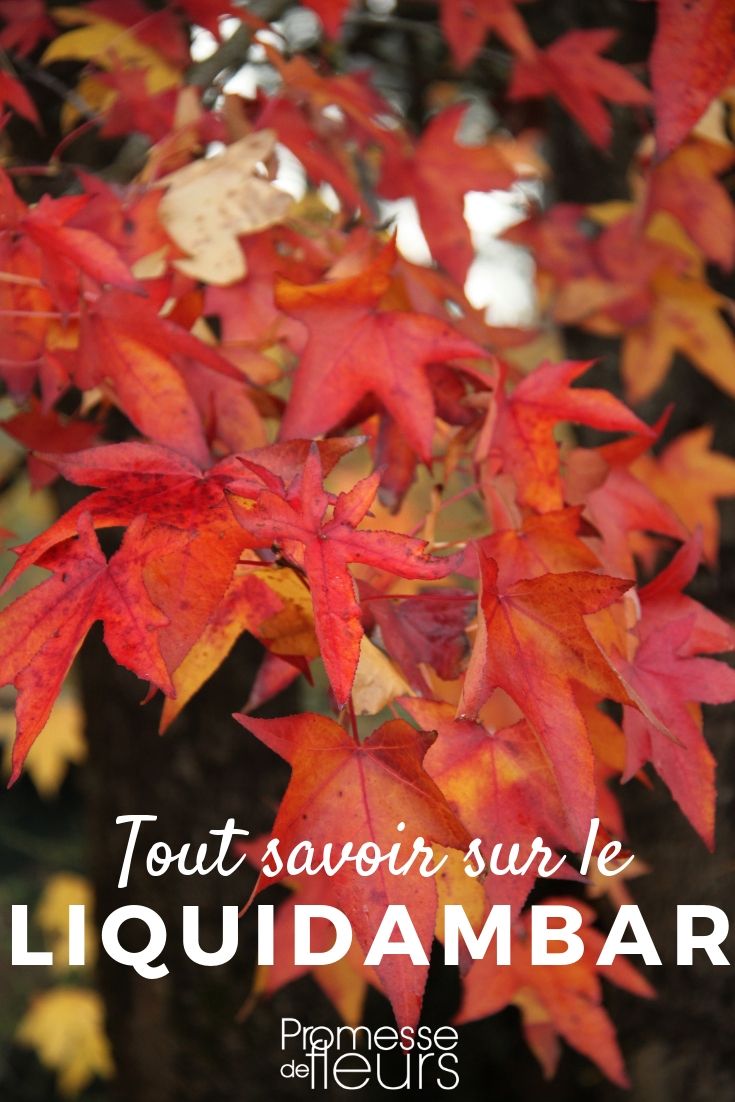































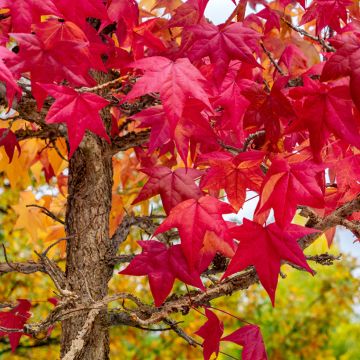



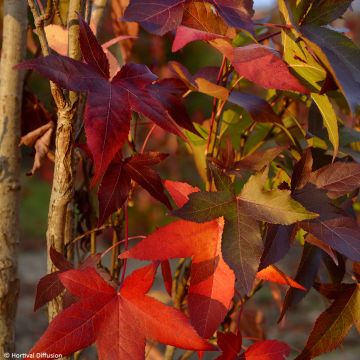

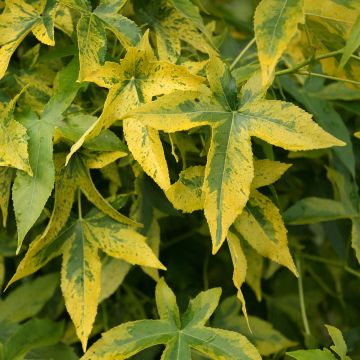
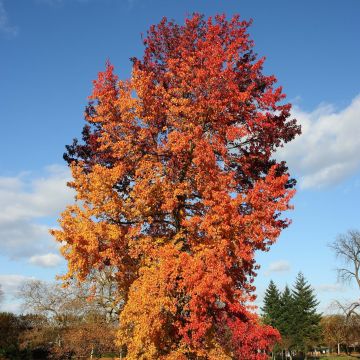


Comments